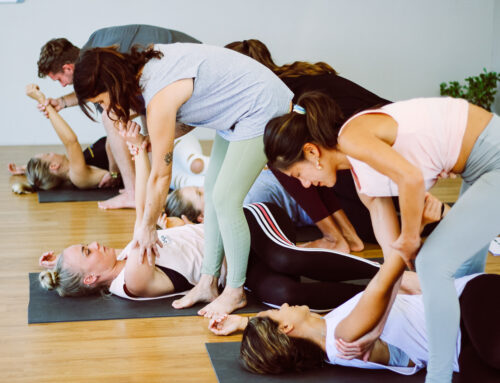“We are all born divine and each human being has the intelligence and inner resources to heal themselves” – Maria Kirsten
Each and every one of us is unique. We are born with different constitutions, bodies and minds. We then gather a collection of diverse experiences that shape who we are and how we navigate our way through the world. As we grow and mature, we continue to experience and express our uniqueness but there are two things I believe we all have in common; the desire to connect with ourselves and the desire to connect with others.
Yoga supports us in the navigation process with both formal and informal self-enquiry practices. Through practice we develop proprioception and interoception, we figure out how to skilfully position ourselves on the mat, and in turn in the world. We learn about our bodies and our minds, our boundaries and our potential. But different styles of practice emphasise different things. Some focus more on proficiency in Asana, others on chanting, studying scripture, or meditation. There are so many options when it comes to yoga these days, so the question really becomes what should we practice and “HOW should we practice”? This has become an important contemplation in my life as a yoga student and teacher.
I believe the answer is quite simple. We should practice in a way that best supports us to gracefully navigate change, manage challenge, and thrive in the world.

I was not always practicing in a way that was supporting my wellbeing. During my early practice years, I was attending hot vinyasa classes with an emphasis on aesthetics and form (or perhaps that was my impression of what was important at that time in my journey). I would show up to class for an hour a day, sometimes two, then step back into my routine in the world without a moment of pause. I did not spend any time in stillness or contemplation outside of the four walls of the studio. Needless to say, I was practicing, but I was not managing challenge all that gracefully, and I definitely didn’t feel like I was thriving. This changed over time as I naturally became more reflective and interested in what yoga was doing to me on a deeper level. This led to more and more practice.
Unfortunately, more practice lead to more pain. Around the age of 26 I started experiencing serious Sacroilliac discomfort, hip pain, and shoulder pain. Not only did I suffer in practice but activities of daily living became difficult. This made little sense to me because I was “such a dedicated yogi” with sound knowledge about anatomy and biomechanics. One of the reasons I started practicing in the first place was to stay fit, healthy and pain free after many injuries as a competitive athlete. I wondered “what am I doing wrong?”
I wasn’t necessarily doing anything wrong, but I also wasn’t practicing “right”. I was obviously practicing in a way that was hurting my body instead of supporting it and this seemed to be a common theme amongst practitioners. As an ex high-level athlete, I was used to pushing through pain and so I loved that yoga emphasised a pain-free philosophy. I remember my teacher would say “if it hurts, modify or rest in Childs pose” but at that point I had not done a yoga teacher training, I was not educated about modifications, and I certainly didn’t feel like I was getting my money’s worth by being in Childs pose every time a vinyasa was offered. My body was sending me some pretty strong pain signals and eventually I had no choice but to listen.
I was devastated at the thought of not being able to practice. What I didn’t realise then was that Asana can be practiced and approached in many different ways. As I mentioned before, we are all unique, so it makes sense that we may need different practice ingredients at different times to best support our practice and our lives.
This is the philosophy of Remedial Yoga. Influenced by the great Krishnamacharya and passed down through the Vini yoga lineage (Vini = adaptation), Remedial Yoga emphasises adapting traditional practices to make yoga accessible for every ‘body’. It puts the individual first and considers every aspect of their being including physical, mental, emotional and spiritual. It takes “can’t” and turns it into “let’s find another way”.

To me, the journey of “finding another way” is one of the most exciting and empowering parts of this practice. Asana is just the tip of the iceberg and Remedial practice offers a variety of tools and techniques to explore what lies under the surface. It is the application of traditional practice into a modern world.
When I learned about the Remedial Yoga process, the energetics of asanas and how to properly modify to suit my needs and goals, my whole perspective on practice changed and I was able to practice pain-free. This approach has been informing my practice and my teaching ever since. It is what has allowed me to keep practicing all of the styles of yoga I love, safely. I strongly believe that understanding yoga through the lens of Remedial practice is an empowering way for any practitioner to move gracefully through this wild world.
By Bec Isaacs @becisaacs
Bec has taken up the mantel of Maria’s teachings and adapted our Remedial Yoga manual to offer a course that incorporates Maria’s approach while also adding her own focus on a holistic foundation that extends beyond asana. More details of the course here






